Unfortunately, much of the U.S. still requires a car to get around effectively, but in many communities, there are good alternatives.
In small towns and dense urban areas, walking can be a great way to get around.
Bikes can also be great, although safety can be an issue for bikers. An experienced bicyclist is able to slip through traffic, avoiding backed-up traffic at major intersections. Bikers can also access dedicated rights-of-way that cars do not have access to, including walking their bikes through pedestrian-only thoroughfares.
Public transit is better in some areas than others, but it can still be a great way to avoid getting stuck in a car. Train commutes, whether subways or above-ground trains, can be the best option when they have a dedicated right-of-way that bypasses traffic congestion. But even buses and trolleys can sometimes have their advantages.
A long bus ride in which a bus is stuck in traffic is still much more pleasant than being stuck in a car in the same traffic jam. Buses provide much more space to move around, and you avoid the stress of having to drive the car yourself. Public transit also helps keeps cars off the road, so you not only can relax, but you will be helping to alleviate traffic congestion for everyone else too.
In the long-run, consider walkability, bike routes, and public transit options when choosing where to live. Even if your current location isn't easily accessible to these other modes of transit, if and when you move next, you will be able to consider these factors.







 The Shaming of Femininity and Elevation of Masculinityon 07/13/2017
The Shaming of Femininity and Elevation of Masculinityon 07/13/2017
 What is Genderqueer or Non-Binary Gender?on 10/16/2015
What is Genderqueer or Non-Binary Gender?on 10/16/2015
 Resources for Learning Spanish Free Onlineon 04/13/2016
Resources for Learning Spanish Free Onlineon 04/13/2016
 Ways Native Plants Can Help Control Invasive Plantson 05/26/2016
Ways Native Plants Can Help Control Invasive Plantson 05/26/2016


Questions? Comments? Feedback?
Yeah...Philly gets more gridlock than most cities I've lived in, because of narrower streets (lots of which are only 1-lane) and it can get really bad. When even one intersection gets blocks, it can cause a cascade reaction blocking many others!
I generally don't drive at all in the densest urban areas though...when I drive here it's in and out of the city, or from point to point in the suburbs. Public transit here is pretty good if you are going between the downtown and other urban areas. It doesn't work for the days when I need to go from point to point in suburbs though.
I live in a big city and grid lock makes rush hour more commonly known as "parking lot" oh how I dislike that... thanks for the great tips to avoid traffic and the hair pulling grid lock of high city traffic.